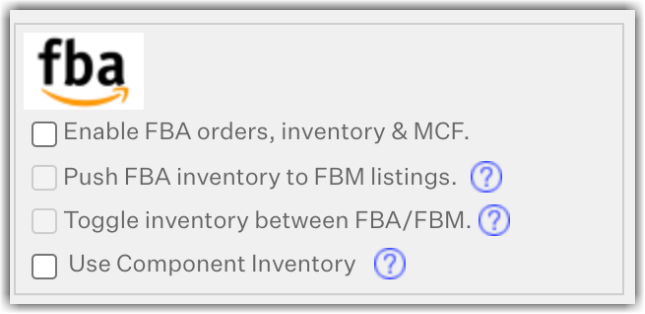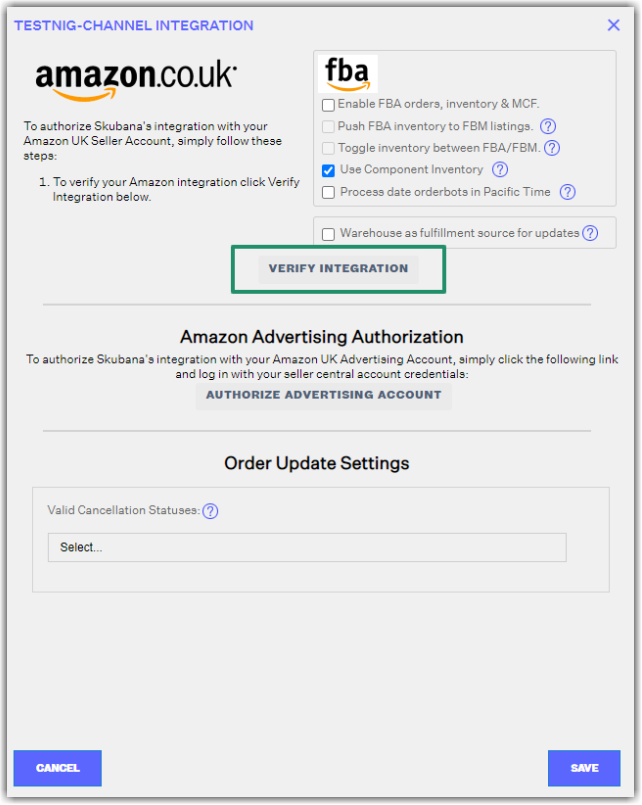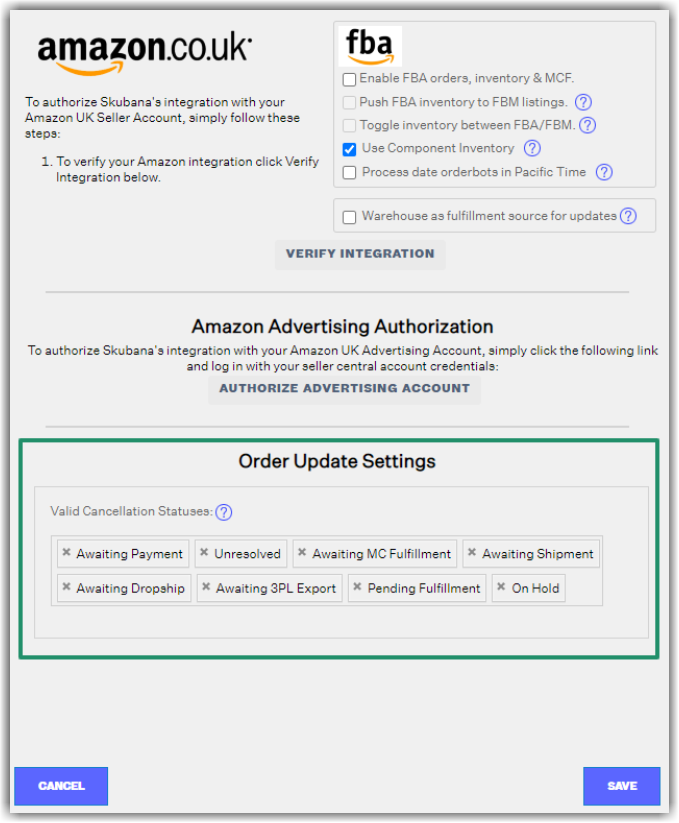-
Settings
-
General
- Configuring Shipping Presets
- Update My Profile
- Disable the Inventory Update From Extensiv Order Manager to All Sales Channels
- How to Enable Out of Stock Control for eBay Sales Channels
- Company Info and Additional Account Settings
- Installing an App from the Order Manager App Store
- How to View Your Extensiv Order Manager Invoices
- How To Remove an App in Order Manager
- Ruby Has 3PL Integration
- Company Time Zone Setting
- Tax Identifiers
-
Sales Channels
- Deactivating a Sales Channel
- Editing Sales Channels
- Enable or Disable Extensiv Order Manager Email Notifications to Your Customers
- Shopify Tags
- Shopify Locations
- Amazon Cancellation Settings
- Steps in Adding Walmart as a Sales Channel
- Adding Newegg as a Sales Channel
- Adding eBay as a Sales Channel
- Viewing a Sales Edit Channel's History
- Reactivating Sales Channels
- Adding Amazon as a Sales Channel
- Adding Shopify as a Sales Channel
- Adding a Manual Sales Channel
- Adding Sales Channels
- Assigning a Packing Slip and/or Email Template to your Sales Channel
- How to Exclude a Warehouse From Pushing Inventory to a Sales Channel
- Setting Up Shipment & Carrier Mappings for Your Sales Channels
- Amazon Pacific Time Orderbot Setting
- Walmart Fulfillment Services - WFS
- WFS Workflow
-
Webhooks
- Order Creation Webhook
- Shopify Cancellation Webhook
- Shopify Refund Webhook - POS Orders
- Shopify Fulfillment Webhook
- Shopify Refund Webhook (e-commerce Orders)
- Shopify Product Deletion Webhook
- BigCommerce Webhook
- Shopify Product Update / Product Edit Webhook
- Shopify Auto-Subscribing Webhooks
- Order Payment Webhook
-
Shipping Providers
- Adding FedEx as a Shipping Provider
- How to Add Express 1 as a Shipping Provider
- Adding Amazon Buy Shipping as a Shipping Provider
- UPS Mail Innovations Services
- Adding DHL eCommerce as a Shipping Provider
- FedEx ETD
- Deactivate or Reactivate a Shipping Provider
- Adding Shipping Providers
- Customizing Shipping Services and Package Types Per Shipping Provider
- Vendors
-
Warehouses & Vendors
- Creating and Configuring Warehouses in Extensiv Order Manager
- Can I have additional order information populated on my Shipping label?
- Configuring Shipping Label Print Format Options
- Inventory Dependent Warehouses
- How to Configure the Order Export File for FTP Connections
- Deactivating a Warehouse in Extensiv Order Management
- Updating the Address/Return Address for Your Warehouse
- Search for Vendors
- Configuring a Dropship Vendor
- Creating an In-House Warehouse
- How do I connect Extensiv Order Manager with Deliver?
- Configuring Dropship Vendor FTP
- FTP Inventory Import for a 3PL
- Setting Up Domestic Backup Warehouses
- Setting Up a Warehouse's International Rank
- Pick List Settings
- Setting Up a 3PL Warehouse
- Setting Up Document Print Settings
- Setting a Dropship Template and Fulfilling Orders with a P.O.
- Use Component Inventory Setting for Bundles and Kits
- Instructional Video - Creating Warehouses & Warehouse Settings
-
Orderbots
- Orderbots - Complete List of Filters & Actions
- Postal Zones in Extensiv Order Manager
- Automating Orders to Fulfill from a Specific Warehouse
- Editing an Orderbot
- Deactivating an Orderbot in Extensiv Order Manager
- Mark Order as Shipped Orderbot
- Replace Address Orderbot
- Creating an Orderbot
- Support for Shopify's Additional Details
- Orderbots filtered by zip code range
- Adding Order Item to Order Orderbot Action
- Commonly Used Orderbots
- Understanding Apply Best Rate vs Cheapest Rate Orderbots
- Orderbot: Set order weight and dimensions based on products
- Orderbot: Using Hold the order for and Mark Order as Shipped
- Templates
-
General
Adding Amazon as a Sales Channel
Extensiv Order Manager offers out-of-the-box integrations with various sales channels. For general instructions on adding a sales channel to Order Manager, see Adding Sales Channels.
The procedure outlined below also applies to other Amazon marketplaces that can be one-click integrated with Order Manager, ie: Amazon.ca, Amazon.com.mx, Amazon.co.uk, Amazon.de, Amazon.fr, Amazon.es, and Amazon.it.
An Amazon account can only be connected by the account owner/primary user of the Amazon selling account.
To add an Amazon account as a sales channel
- On the New Sales Channel popup, select amazon.com from among the various channels.

NOTE: If you are adding a new sales channel for an Amazon channel that is not Amazon US, select the corresponding icon from the options. Order Manager offers a native Amazon integration with (Canada, Mexico, United Kingdom, Germany, France, Spain, Italy, China, & Australia)
- On the Amazon.com Integration window, you need to authorize the Extensiv integration with your Amazon Seller Account. Simply click Authorize Order Manager to be redirected to Amazon and approve Order Manager’s permissions. Once you agree, you will be redirected back to the Order Manager.

Back in the Amazon.com Integration window in the Order Manager:
- If you use FBA, you can choose to enable or disable FBA orders, inventory & MCF, push FBA inventory to FBM listings, and toggle inventory between FBA/FBM listings in the top right corner. Checking the corresponding box enables the options, and unchecking disables them. In order to use the bottom two features, the first box to enable FBA must be checked.
 Checking this option will automatically create an FBA Warehouse in your Inventory Module (called [your channel name] "Dist. Center").
Checking this option will automatically create an FBA Warehouse in your Inventory Module (called [your channel name] "Dist. Center").NOTE
Enabling FBA orders, inventory and MCF means that Amazon will pass information about orders, inventory, and MCF to the Order Manager.
FBA orders will automatically import into the Order Manager and will naturally land directly in the Shipped status under the respective Amazon Dist. Center for that sales channel. All FBA orders imported from Amazon will be listed as "FBA" after the sales channel name. FBA orders may land under the Unresolved status if they are missing critical order info (like a Master SKU), but once resolved, will land in Shipped status.
Pushing FBA inventory to FBM listings means sharing your FBA inventory with your FBM inventory, e.g. if you have 50 units in your FBA inventory, this is the same number reflected in your FBM inventory.
Toggling inventory between FBA and FBM listings means that when an Amazon listing is out of stock as an FBA listing, it will automatically functionally convert to an FBM listing in the Order Manager (it will look the same), at which point we will push FBM inventory to the listing in Seller Central.
When it is replenished at FBA, it will be converted back to an FBA listing and the Order Manager will no longer push inventory to the listing in Seller Central.
You can monitor a product's toggle history in its Product Edit History.
Use Component Inventory is a setting that you can choose to enable/disable depending on how you want to count bundle/kit inventory for FBA Warehouses. - Click Verify Integration to test and confirm that the Order Manager's connection with Amazon is live.”

Once the integration is completed, you will see Amazon added to your sales channels. - After you've successfully added your new Amazon sales channel, you can edit it. Highlight the new Amazon channel in the channel list and click Edit. Go to the Connection tab and click Edit Integration.
You should now see two more sections that were not there when you created the channel.- Amazon Advertising Authorization: Click Authorize and log into Amazon with your Seller Central account credentials if you want to allow Order Manager to pull PPC Advertising Reports data into Analytics, Performance By SKU report. Amazon provides a daily ads report that is broken down by Listing SKU.
-
Order Update Settings: Currently, the Amazon integration offers one webhook, the Cancellation webhook. To utilize it, select at least one order status in the boxed area found at the bottom of the window. Any order status indicated and saved here will allow the Order Manager to cancel an order that was canceled directly on Amazon. If an order is in an order status that was not saved here, then the webhook will not be allowed to apply to that order.

 | Help Center
| Help Center
